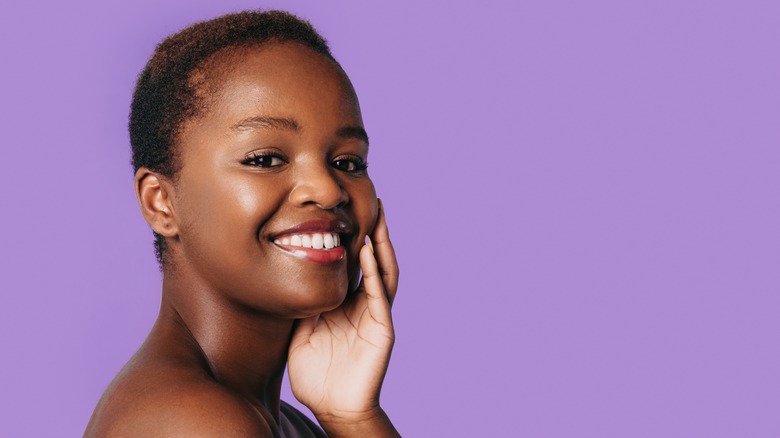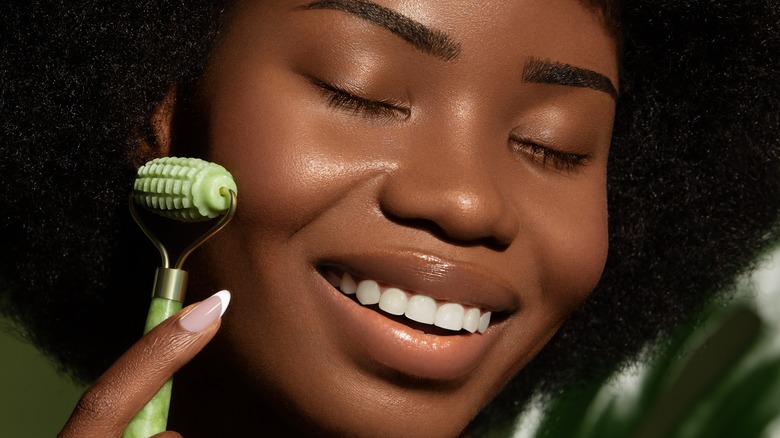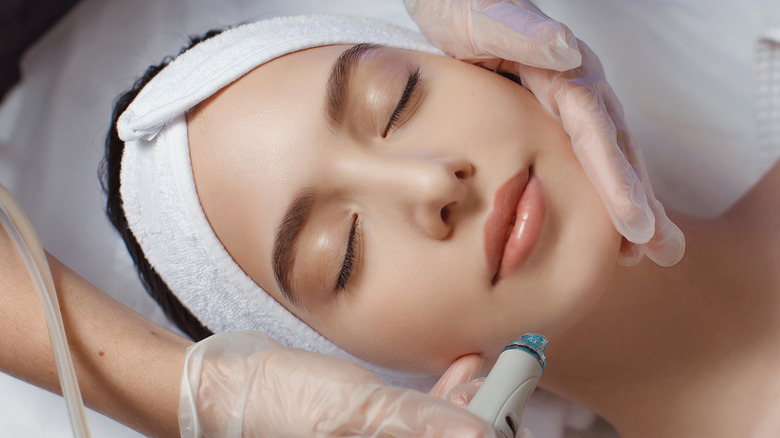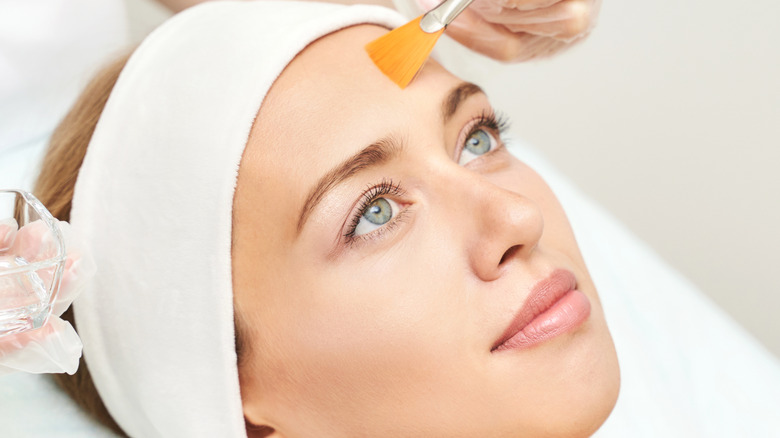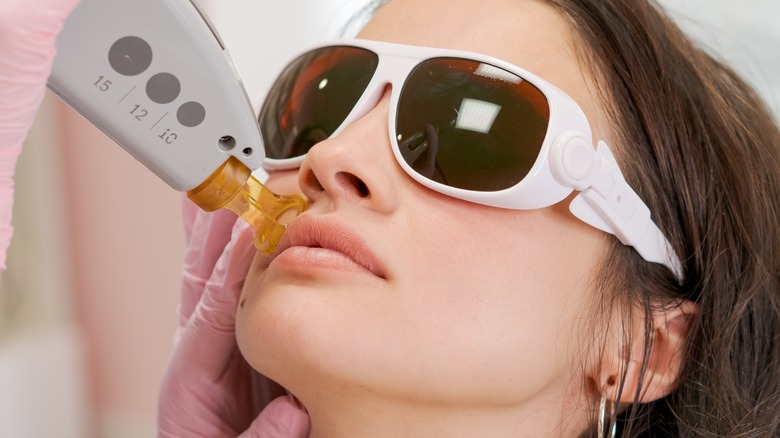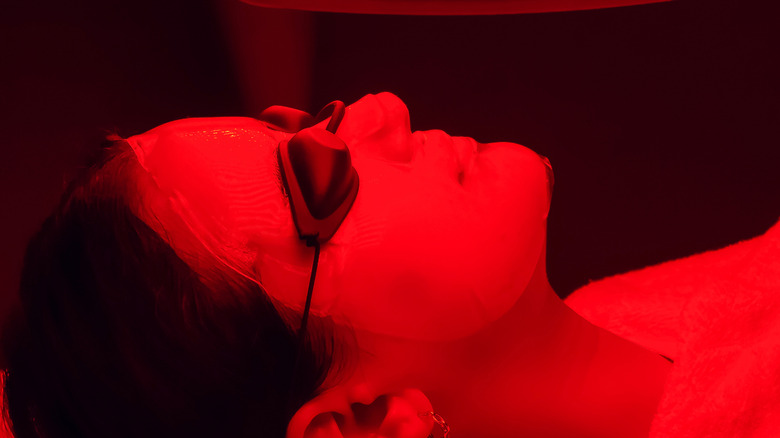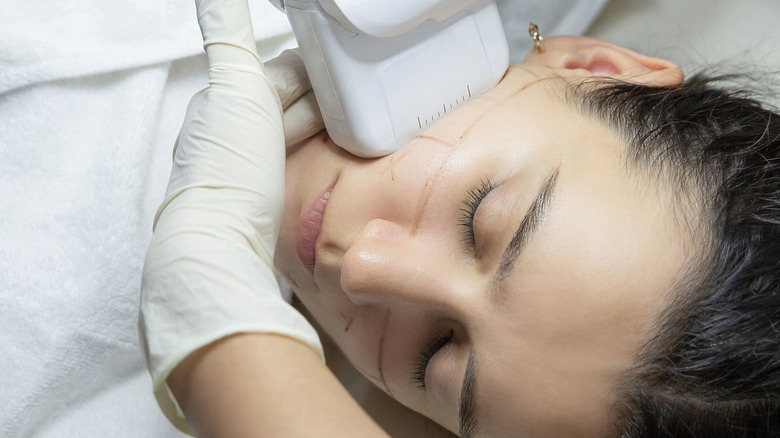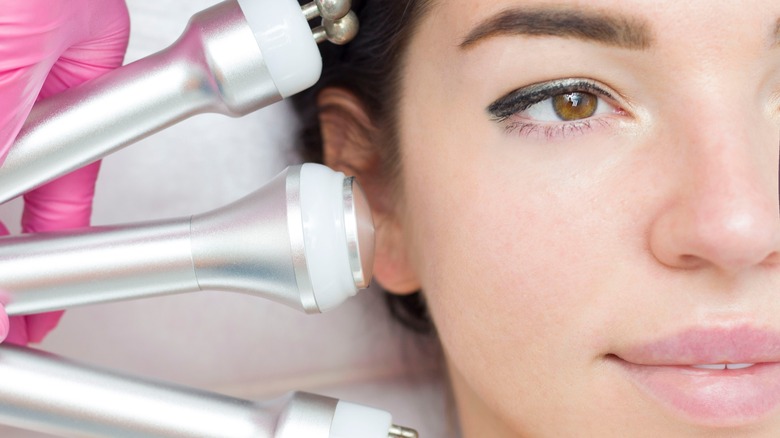If You Want Botox But Are Afraid Of Needles, Do This Instead
When it comes to smoothing out wrinkles and restoring the skin to a smooth and youthful appearance, Botox is usually a popular option. An FDA-approved anti-aging treatment, Botox eliminates wrinkles by temporarily relaxing the muscles underneath the skin, per MedlinePlus. Frown lines, forehead lines, crow's feet, bunny lines, and the upper lip are among the areas on the face that can be injected with Botox for a smoother appearance. Dermal fillers are also an effective method of diminishing the appearance of wrinkles by increasing the skin volume and giving it a fuller, smoother look, as Cleveland Clinic points out. Botox and fillers are both tried-and-true methods for slowing down the visible signs of aging.
However, these methods both involve needles. For those with a chronic fear of sharp objects (aichmophobia or trypanophobia) or who have a record of traumatic experiences with needles, these injectables might be an undesirable option. If that's you, rest assured that there are plenty of syringe-free alternatives that can make excellent additions to your anti-aging routine. Below, check out the most popular non-invasive, needle-free options to tighten sagging skin and rejuvenate your complexion.
Jade rolling
Hailing from ancient China, jade rolling is a user-friendly method for tightening and soothing the skin. Don't discount the impact of this old-fashioned, simple device. Jade rollers, which are hand-sized tools with a cylinder of jade or quartz stone, were a staple in the beauty regimens of affluent Chinese women during the Qing dynasty dating back to the early 17th century. At the time, these women believed a precious stone like jade had a special capacity for healing and calming, which gave them a good reason to massage their skin with jade rollers to keep it firm and youthful.
"Jade rolling is thought to work by aiding in lymphatic drainage [moving fluid that pools under skin], which can have a depuffing effect," chemist Sabina Wizemann explained to Good Housekeeping. To further soothe inflammation, constrict pores, and lessen the visibility of wrinkles, you can even pop the roller into the fridge. Although jade rolling itself is not acknowledged as an anti-aging treatment, it can work wonders in relaxing facial tension and promoting blood circulation. To use a jade roller, acupuncturist Ross J. Barr says that the trick is to roll up and away. As Barr explained to Harper's Bazaar, "Imagine the bridge of your nose is the central point and roll away from that in all directions. Imagine you are very gently rolling all the toxin build-up outward and downwards, finally rolling outward along your jaw and down the channel that runs down your neck by your ear."
Microdermabrasion
According to the NHS, microdermabrasion is a cosmetic procedure that first involves spraying fine crystals onto the skin surface through a tube to slough away dead skin cells from the top layer of the skin, then vacuuming away the crystals and skin particles to reveal smooth and silky skin. Not only can microdermabrasion help diminish the appearance of fine lines and wrinkles, but it also targets minor scars, age spots, and sunspots. Microdermabrasion also stimulates the production of collagen in the skin to keep it firm and elastic from the inside. Because microdermabrasion buffs away dead skin cells and impurities on a deep level, it can even out your skin tone and improve mild acne. After each microdermabrasion treatment, your skin will feel softer and smoother.
However, microdermabrasion has certain limitations. It cannot remove deep wrinkles and significant scars, but rather soften fine lines and superficial wrinkles, per MedicineNet. To reap the maximum anti-aging benefits from this procedure, you might have to adopt other topical treatments in addition to microdermabrasion facials. Multiple and consistent microdermabrasion sessions may be required to achieve treatment goals and preserve results.
Chemical peels
Wrinkled, crepey skin can also be improved through chemical peels, which involve buffing away the top layer of skin with a chemical solution, according to the American Society for Dermatologic Surgery (ASDS). Similar to microdermabrasion, chemical peels exfoliate your skin to give it a fresh feel and an even appearance. Its ability to regenerate skin makes it a go-to remedy for the treatment of wrinkles, blemishes, sun damage, and acne scars. While microdermabrasion can tackle superficial fine lines, chemical peels can go deeper and treat deep wrinkles and scars.
According to Lovoir Beauty, salicylic acid, lactic acid, trichloroacetic acid, and carbolic acid, which all differ in potency and skincare benefits, are commonly used in chemical peels. Depending on your skin condition, your dermatologist will use a single-acid solution or a combination of multiple acids on your skin. Because of the potency, you'll feel a burning sensation lasting five to 10 minutes once the solution is applied to your skin, per ASDS. After a deep peel, you will experience redness, swelling, and even pain, but your doctor will prescribe you painkillers or give you tips on reducing the discomfort in the treated areas. You should start seeing noticeable improvements in the treated areas two weeks following a peel, such as smoother skin and less visible facial wrinkles. After a peel, your skin will most likely be incredibly sensitive, therefore you must take extra care of it as sun exposure can cause new wrinkles and skin discoloration.
CO2 laser treatment
An effective treatment for wrinkles, CO2 laser treatments go to work by resurfacing the skin and removing underlying layers to facilitate the growth of new, healthy skin, per Cleveland Clinic. Aside from treating fine lines, CO2 laser treatments can also diminish the appearance of acne scars, warts, and blemishes. To minimize discomfort during the treatment, patients are usually administered local anesthesia.
It's also worth pointing out that CO2 lasers are ablative, meaning they remove the outer layer of the skin and are therefore stronger than non-ablative skin resurfacing treatments (via the Mayo Clinic). This means that CO2 lasers are more effective at treating deep-set lines, visible facial scarring, and significant skin discoloration. If you have textured skin and would like to see dramatic significant improvements within a short amount of time, a CO2 laser treatment may be just the ticket. If your skin is only showing minimal signs of aging and you don't mind undergoing multiple treatments with a less invasive treatment, check out non-ablative laser treatments such as pulsed-dye lasers or Erbium lasers.
LED light therapy
According to the American Society of Plastic Surgeons, LED light therapy can stimulate the production of collagen and reduce wrinkles as well as skin inflammation. LED light therapy employs various wavelengths that are able to penetrate through different layers of the skin. For instance, blue light can reduce oil gland production resulting in less oily skin, while red light is effective in reducing inflammation and fine lines as well as stimulating collagen creation.
While you can incorporate LED light therapy into your daily skincare routine, such as wearing an LED light mask or using a therapy wand on your face, it's better to seek in-office treatments where you can get expert advice on what works for your skin type and be treated with medical-grade equipment. In addition to using light therapy, you can also incorporate topical treatments that contain vitamin C, retinol, and other anti-aging products to achieve optimal results.
High-Intensity Focused Ultrasound (HIFU)
High-Intensity Focused Ultrasound (HIFU) is another effective non-surgical option for tightening sagging skin and refining wrinkles for a younger-looking complexion, per RTAesthetics. In a HIFU facial, ultrasound energy is used to heat up underlying tissues, triggering the body to initiate the innate healing process by creating collagen, a protein that gives the skin the elasticity and firmness it needs to stay youthful. A spike in collagen results in firmer and smoother skin. A HIFU treatment can last anywhere between one to three hours, with results lasting up to three years. For optimal results, most dermatologists recommend two HIFU treatments every six months in the first year, followed by one follow-up treatment every year.
According to a study published in the journal Annals of Dermatology, findings from an experiment involving 20 Korean patients with wrinkles and skin laxity revealed that the participants reported the most improvements in the jawline, cheek, and around the mouth after a single session of HIFU treatment. There were some adverse effects such as bruising and swelling, but they were mild and short-lived. HIFU is highly recommended for those aged above 30 years old suffering from mild to moderate skin laxity.
Radio-frequency (RF) treatment
According to Okotoks Eyecare, radio-frequency (RF) is the process of delivering thermal heat in the range of 122 to 167 degrees Fahrenheit to your skin to facilitate the production of collagen. In other words, the RF process allows the radio waves to penetrate the skin's surface to heat up the underlying tissues, and inflict a controlled injury that sets off the body's natural healing process and causes the production of collagen, elastin, and hyaluronic acid, as dermatologist Dr. Tony Nakhla points out to Allure. The release of these substances helps to keep your skin tight and hydrated.
Aside from tightening crepey skin and reducing the appearance of fine lines, RF can also make facial scarring and sun damage less noticeable. Requiring minimal downtime, RF can restore to you a tighter and lifted complexion after the skin heals. RF treatments can be performed on both the face and the body to tighten the skin and reduce excess fat. One RF session takes about an hour to complete, and you can expect to reach your treatment goals after three to four sessions. Depending on your needs, you can opt to have an in-office RF treatment or buy an FDA-approved RF device and treat mild to moderate wrinkles at home.
